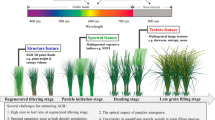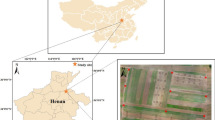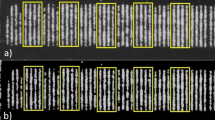Abstract
Crop aboveground biomass (AGB) is one of the most important indicators in crop breeding and crop management, and can be used for crop yield prediction. A number of vegetation indices (VIs) have been proposed to estimate crop biomass, but they perform poorly at high biomass levels and are easily affected by background materials. Texture analysis has been proved to be an efficient approach in forest biomass estimation, but has never been applied to crops with low-altitude unmanned aerial vehicle (UAV) images. The objective of this study was to improve rice AGB estimation by combining textural and spectral analysis of UAV imagery. A two-year rice experiment was conducted in 2015 and 2016, involving different nitrogen (N) rates, planting densities and rice cultivars with three replicates. A six-band multispectral (MS) camera was mounted on a UAV to acquire rice canopy images at critical stages during the rice growing seasons and concurrent field samplings were taken. Simple regression and stepwise multiple linear regression models were developed between biomass data from the two-year experiment and image parameters derived from four different types of feature sets. These features represented commonly used VIs, texture parameters, normalization of texture measurements (normalized difference texture index, NDTI) and combinations of VIs and NDTIs. Finally, all the regression models were evaluated by cross-validation over pooled data with the coefficient of determination (R2) and the root mean square error (RMSE). Results demonstrated that the optimized soil adjusted vegetation index (OSAVI) exhibited the best relationship with AGB for the whole season (R2 = 0.63) and post-heading stages (R2 = 0.65). Red-edge-based indices yielded best performance (R2 > 0.70) only for the growth stages before heading. The texture measurement mean (MEA) from the NIR band was the best among the eight candidates in AGB estimation. Texture index (NDTI (MEA800, MEA550)) was superior to all the evaluated VIs in estimating AGB for the whole season (R2 = 0.75) and pre-heading stages (R2 = 0.84). Further improvement was obtained across the whole season by combining NDTIs and VIs through a multiple linear regression. This multivariate model produced the highest estimation accuracy for all stages (R2 = 0.78 and RMSE = 1.84 t ha−1) and different stage groups (R2 = 0.84 and RMSE = 1.06 t ha−1 for pre-heading stages and R2 = 0.65 and RMSE = 1.94 t ha−1 for post-heading stages). The findings imply that the integration of textural information with spectral information significantly improves the accuracy for rice biomass estimation compared to the use of spectral information alone.







Similar content being viewed by others
References
Ata-Ul-Karim, S. T., Yao, X., Liu, X., Cao, W., & Zhu, Y. (2013). Development of critical nitrogen dilution curve of Japonica rice in Yangtze River Reaches. Field Crops Research, 149, 149–158.
Battude, M., Bitar, A. A., Morin, D., Cros, J., Huc, M., Sicre, C. M., et al. (2016). Estimating maize biomass and yield over large areas using high spatial and temporal resolution Sentinel-2 like remote sensing data. Remote Sensing of Environment, 184, 668–681.
Belsley, D. A. (1991). Conditioning diagnostics: Collinearity and weak data in regression. New York, USA: Wiley.
Bendig, J., Bolten, A., Bennertz, S., Broscheit, J., Eichfuss, S., & Bareth, G. (2014). Estimating biomass of barley using crop surface models (CSMs) derived from UAV-based RGB imaging. Remote Sensing, 6, 10395–10412.
Bendig, J., Yu, K., Aasen, H., Bolten, A., Bennertz, S., Broscheit, J., et al. (2015). Combining UAV-based plant height from crop surface models, visible, and near infrared vegetation indices for biomass monitoring in barley. International Journal of Applied Earth Observation and Geoinformation, 39, 79–87.
Cantrell, R. P., & Reeves, T. G. (2002). The cereal of the world’s poor takes center stage. Science, 296, 53.
Cao, Q., Miao, Y., Feng, G., Gao, X., Li, F., Liu, B., et al. (2015). Active canopy sensing of winter wheat nitrogen status: An evaluation of two sensor systems. Computers & Electronics in Agriculture, 112, 54–67.
Chen, D., Stow, D. A., & Gong, P. (2004). Examining the effect of spatial resolution and texture window size on classification accuracy: An urban environment case. International Journal of Remote Sensing, 25, 2177–2192.
Cheng, T., Song, R., Li, D., Zhou, K., Zheng, H., Yao, X., et al. (2017). Spectroscopic estimation of biomass in canopy components of paddy rice using dry matter and chlorophyll indices. Remote Sensing, 9, 319.
Coburn, C. A., & Roberts, A. C. B. (2004). A multiscale texture analysis procedure for improved forest stand classification. International Journal of Remote Sensing, 25, 4287–4308.
Datt, B. (1999). Visible/near infrared reflectance and chlorophyll content in Eucalyptus leaves. International Journal of Remote Sensing, 20, 2741–2759.
Dorigo, W., Lucieer, A., Podobnikar, T., & Čarni, A. (2012). Mapping invasive Fallopia japonica by combined spectral, spatial, and temporal analysis of digital orthophotos. International Journal of Applied Earth Observation and Geoinformation, 19, 185–195.
Dormann, C. F., Elith, J., Bacher, S., Buchmann, C., Carl, G., Carré, G., et al. (2013). Collinearity: A review of methods to deal with it and a simulation study evaluating their performance. Ecography, 36, 27–46.
Eckert, S. (2012). Improved forest biomass and carbon estimations using texture measures from WorldView-2 satellite data. Remote Sensing, 4, 810–829.
Gitelson, A. A., Andrés, V., Arkebauer, T. J., Rundquist, D. C., Galina, K., & Bryan, L. (2003). Remote estimation of leaf area index and green leaf biomass in maize canopies. Geophysical Research Letters, 30, 335–343.
Gitelson, A. A., Andrés, V., Verónica, C., Rundquist, D. C., & Arkebauer, T. J. (2005). Remote estimation of canopy chlorophyll content in crops. Geophysical Research Letters, 32, 93–114.
Gitelson, A. A., Kaufman, Y. J., & Merzlyak, M. N. (1996). Use of a green channel in remote sensing of global vegetation from EOS-MODIS. Remote Sensing of Environment, 58, 289–298.
Gitelson, A. A., Kaufman, Y. J., Stark, R., & Rundquist, D. (2002). Novel algorithms for remote estimation of vegetation fraction. Remote Sensing of Environment, 80, 76–87.
Gnyp, M. L., Miao, Y., Yuan, F., Ustin, S. L., Yu, K., Yao, Y., et al. (2014). Hyperspectral canopy sensing of paddy rice aboveground biomass at different growth stages. Field Crops Research, 155, 42–55.
Grossman, Y. L., Ustin, S. L., Jacquemoud, S., Sanderson, E. W., Schmuck, G., & Verdebout, J. (1996). Critique of stepwise multiple linear regression for the extraction of leaf biochemistry information from leaf reflectance data. Remote Sensing of Environment, 56, 182–193.
Haboudane, D., Miller, J. R., Pattey, E., Zarco-Tejada, P. J., & Strachan, I. B. (2004). Hyperspectral vegetation indices and novel algorithms for predicting green LAI of crop canopies: Modeling and validation in the context of precision agriculture. Remote Sensing of Environment, 90, 337–352.
Haralick, R. M., Shanmugam, K., & Dinstein, I. H. (1973). Textural features for image classification. IEEE Transactions on Systems, Man & Cybernetics, 6(3), 610–621.
Hatfield, J. L., Gitelson, A. A., Schepers, J. S., & Walthall, C. L. (2008). Application of spectral remote sensing for agronomic decisions. Agronomy Journal, 100, 117–131.
Huete, A. R., Jackson, R. D., & Post, D. F. (1985). Spectral response of a plant canopy with different soil backgrounds. Remote Sensing of Environment, 17, 37–53.
Hunt, E. R., Cavigelli, M., Cst, D., Mcmurtrey, J. I., & Walthall, C. L. (2005). Evaluation of digital photography from model aircraft for remote sensing of crop biomass and nitrogen status. Precision Agriculture, 6, 359–378.
Kelcey, J., & Lucieer, A. (2012). Sensor correction of a 6-band multispectral imaging sensor for UAV remote sensing. Remote Sensing, 4, 1462–1493.
Kelsey, K., & Neff, J. (2014). Estimates of aboveground biomass from texture analysis of Landsat imagery. Remote Sensing, 6, 6407–6422.
Koch, B. (2010). Status and future of laser scanning, synthetic aperture radar and hyperspectral remote sensing data for forest biomass assessment. ISPRS Journal of Photogrammetry & Remote Sensing, 65, 581–590.
Kross, A., Mcnairn, H., Lapen, D., Sunohara, M., & Champagne, C. (2015). Assessment of RapidEye vegetation indices for estimation of leaf area index and biomass in corn and soybean crops. International Journal of Applied Earth Observation and Geoinformation, 34, 235–248.
Laliberte, A. S., & Rango, A. (2009). Texture and scale in object-based analysis of subdecimeter resolution unmanned aerial vehicle (UAV) imagery. IEEE Transactions on Geoscience and Remote Sensing, 47, 761–770.
Lemaire, G., Jeuffroy, M.-H., & Gastal, F. (2008). Diagnosis tool for plant and crop N status in vegetative stage: Theory and practices for crop N management. European Journal of Agronomy, 28, 614–624.
Li, F., Miao, Y., Chen, X., Zhang, H., Jia, L., & Bareth, G. (2010). Estimating winter wheat biomass and nitrogen status using an active crop sensor. Intelligent Automation & Soft Computing, 16, 1221–1230.
Li, W., Niu, Z., Chen, H., Li, D., Wu, M., & Zhao, W. (2016). Remote estimation of canopy height and aboveground biomass of maize using high-resolution stereo images from a low-cost unmanned aerial vehicle system. Ecological Indicators, 67, 637–648.
Li, M., Tan, Y., Pan, J., & Peng, S. (2008). Modeling forest aboveground biomass by combining spectrum, textures and topographic features. Frontiers of Forestry in China, 3, 10–15.
Lu, D. (2005). Aboveground biomass estimation using Landsat TM data in the Brazilian Amazon. International Journal of Remote Sensing, 26, 2509–2525.
Lu, D., & Batistella, M. (2005). Exploring TM image texture and its relationships with biomass estimation in Rondônia, Brazilian Amazon. Acta Amazonica, 35, 249–257.
Ning, S. (1998). Remote sensing image texture analysis and fractal assessment. Journal of Wuhan Technical University of Surveying and Mapping, 4.
Normile, D. (2008). Reinventing rice to feed the world. Science, 321, 330–333.
Pearson, R.L., & Miller, L.D. (1972). Remote mapping of standing crop biomass for estimation of the productivity of the shortgrass prairie. In G. Asrar (Ed.), Proceedings of the 8th International Symposium on Remote Sensing of Environment (p. 1355). Ann Arbor, Michigan, USA: Environmental Research Institute of Michigan.
Peng, Y., & Gitelson, A. A. (2011). Application of chlorophyll-related vegetation indices for remote estimation of maize productivity. Agricultural and Forest Meteorology, 151, 1267–1276.
Rondeaux, G., Steven, M., & Baret, F. (1996). Optimization of soil-adjusted vegetation indices. Remote Sensing of Environment, 55, 95–107.
Roth, L., & Streit, B. (2018). Predicting cover crop biomass by lightweight UAS-based RGB and NIR photography: An applied photogrammetric approach. Precision Agriculture, 19, 93–114.
Rouse, J. W., Haas, R. H., Schell, J. A., Deering, D. W., & Harlan, J. C. (1974). Monitoring the vernal advancement and retrogradation (green wave effect) of natural vegetation (pp. 1–371). Greenbelt, MD, USA: NASA/GSFC, Type III, Final Report.
Sarker, L. R., & Nichol, J. E. (2011). Improved forest biomass estimates using ALOS AVNIR-2 texture indices. Remote Sensing of Environment, 115, 968–977.
Schirrmann, M., Giebel, A., Gleiniger, F., Pflanz, M., Lentschke, J., & Dammer, K.-H. (2016). Monitoring agronomic parameters of winter wheat crops with low-cost UAV imagery. Remote Sensing, 8, 706.
Serrano, L., Filella, I., & Penuelas, J. (2000). Remote sensing of biomass and yield of winter wheat under different nitrogen supplies. Crop Science, 40, 723–731.
Smith, G. M., & Milton, E. J. (1999). The use of the empirical line method to calibrate remotely sensed data to reflectance. International Journal of Remote Sensing, 20(13), 2653–2662.
Stamatiadis, S., Taskos, D., Tsadila, E., Christofides, C., Tsadilas, C., & Schepers, J. S. (2010). Comparison of passive and active canopy sensors for the estimation of vine biomass production. Precision Agriculture, 11, 306–315.
Thenkabail, P. S., Smith, R. B., & Pauw, E. D. (2000). Hyperspectral vegetation indices and their relationships with agricultural crop characteristics. Remote Sensing of Environment, 71, 158–182.
Tilly, N., Aasen, H., & Bareth, G. (2015a). Fusion of plant height and vegetation indices for the estimation of barley biomass. Remote Sensing, 7, 11449–11480.
Tilly, N., Hoffmeister, D., Cao, Q., Lenz-Wiedemann, V., Miao, Y., & Bareth, G. (2015b). Transferability of models for estimating paddy rice biomass from spatial plant height data. Agriculture, 5, 538–560.
Tucker, C. J. (1979). Red and photographic infrared linear combinations for monitoring vegetation. Remote Sensing of Environment, 8, 127–150.
Wulder, M. A., Franklin, S. E., & Lavigne, M. B. (1996). High spatial resolution optical image texture for improved estimation of forest stand leaf area index. Canadian Journal of Remote Sensing, 22, 441–449.
Wulder, M. A., Ledrew, E. F., Franklin, S. E., & Lavigne, M. B. (1998). Aerial image texture information in the estimation of northern deciduous and mixed wood forest leaf area index (LAI). Remote Sensing of Environment, 64, 64–76.
Yang, M. D., Huang, K. S., Kuo, Y. H., Hui, T., & Lin, L. M. (2017). Spatial and spectral hybrid image classification for rice lodging assessment through UAV imagery. Remote Sensing, 9, 583.
Yuan, Z., Ata-Ul-Karim, S. T., Cao, Q., Lu, Z., Cao, W., Zhu, Y., et al. (2016). Indicators for diagnosing nitrogen status of rice based on chlorophyll meter readings. Field Crops Research, 185, 12–20.
Zhao, G., Miao, Y., Wang, H., Su, M., Fan, M., Zhang, F., et al. (2013). A preliminary precision rice management system for increasing both grain yield and nitrogen use efficiency. Field Crops Research, 154, 23–30.
Zhou, X., Zheng, H. B., Xu, X. Q., He, J. Y., Ge, X. K., Yao, X., et al. (2017). Predicting grain yield in rice using multi-temporal vegetation indices from UAV-based multispectral and digital imagery. ISPRS Journal of Photogrammetry and Remote Sensing, 130, 246–255.
Acknowledgements
This work was supported by grants from the National Key Research and Development Program of China (2016YFD0300608), the earmarked fund for Jiangsu Agricultural Industry Technology System (JATS[2018]290), the National Science Fund for Distinguished Young Scholars (31725020), the Natural Science Foundation of Jiangsu Province (BK20150663), the Award for Jiangsu Distinguished Professor and the Priority Academic Program Development of Jiangsu Higher Education Institutions (PAPD).
Author information
Authors and Affiliations
Corresponding author
Rights and permissions
About this article
Cite this article
Zheng, H., Cheng, T., Zhou, M. et al. Improved estimation of rice aboveground biomass combining textural and spectral analysis of UAV imagery. Precision Agric 20, 611–629 (2019). https://doi.org/10.1007/s11119-018-9600-7
Published:
Issue Date:
DOI: https://doi.org/10.1007/s11119-018-9600-7




